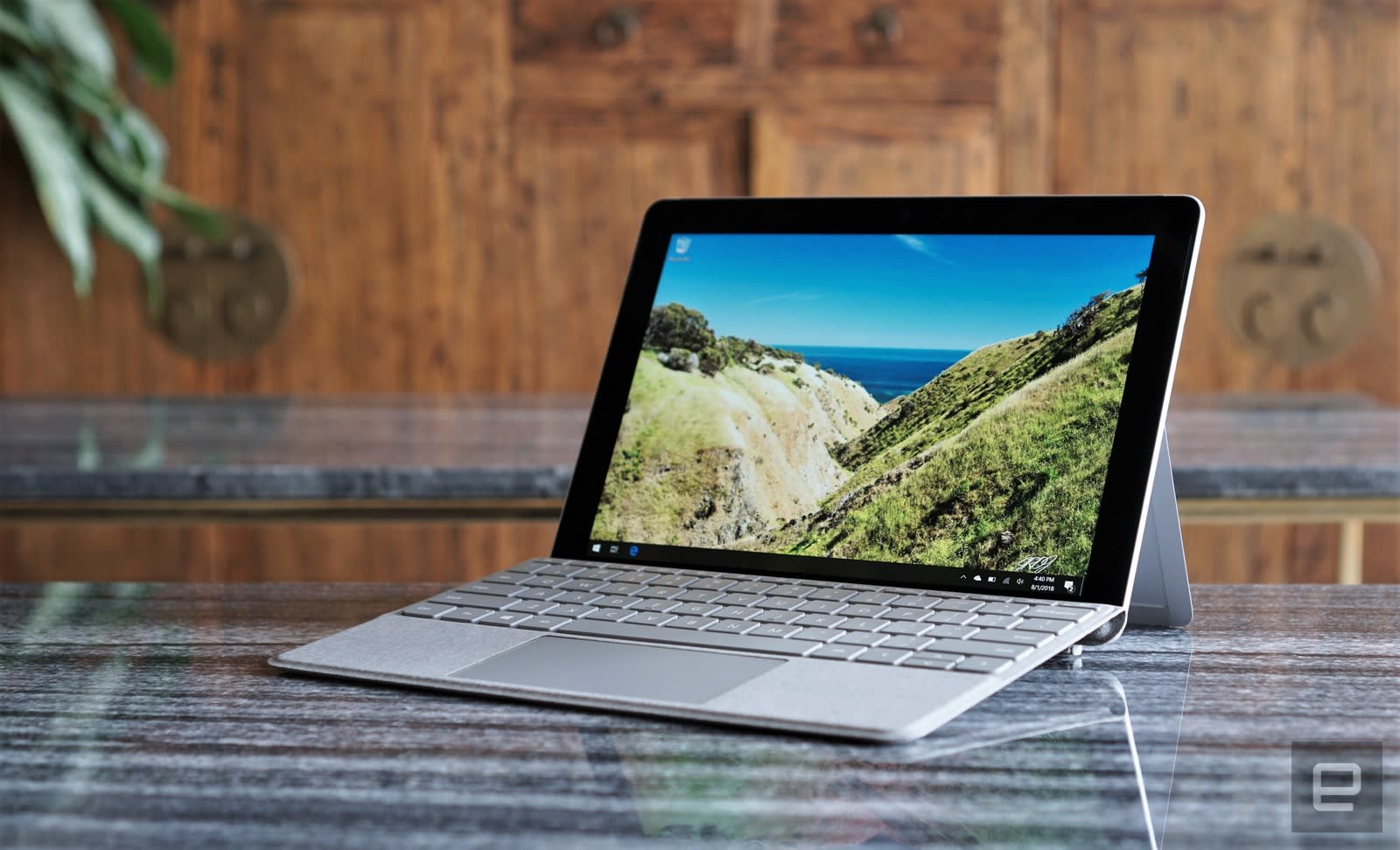 The Surface Go is Microsoft's smallest and cheapest tablet yet, with specs that would make hardware nerds laugh. But in many ways, it brings Microsoft closer to its original dream for the Surface line: It's almost as light as an iPad, but it can also run most of the Windows apps you need. While the Surface Go certainly won't replace more powerful laptops, it's an intriguing option as a secondary device, especially at a low starting price of $399 (without a keyboard). Just be aware of its limitations. Hardware Take any of Microsoft's previous Surfaces, shrink it down a bit, and you've basically got the Surface Go. The silver magnesium case makes a return, and it feels as sturdy and polished as the Surface Pro. Nothing about the Go feels low-end. It even has the articulating kickstand from its big brother, which can open up a full 165 degrees. While it's the successor to the three-year-old Surface 3, the Go is even smaller and lighter at just 1.15 pounds. It also has a 10-inch screen, compared to the Surface 3's 10.8-inch display. It's rare to see such an important specific get smaller in a sequel, but it's all in service of Microsoft's ultimate goal: Making the Surface Go as portable as possible. When I first laid hands on it, I was genuinely surprised by how light it felt. 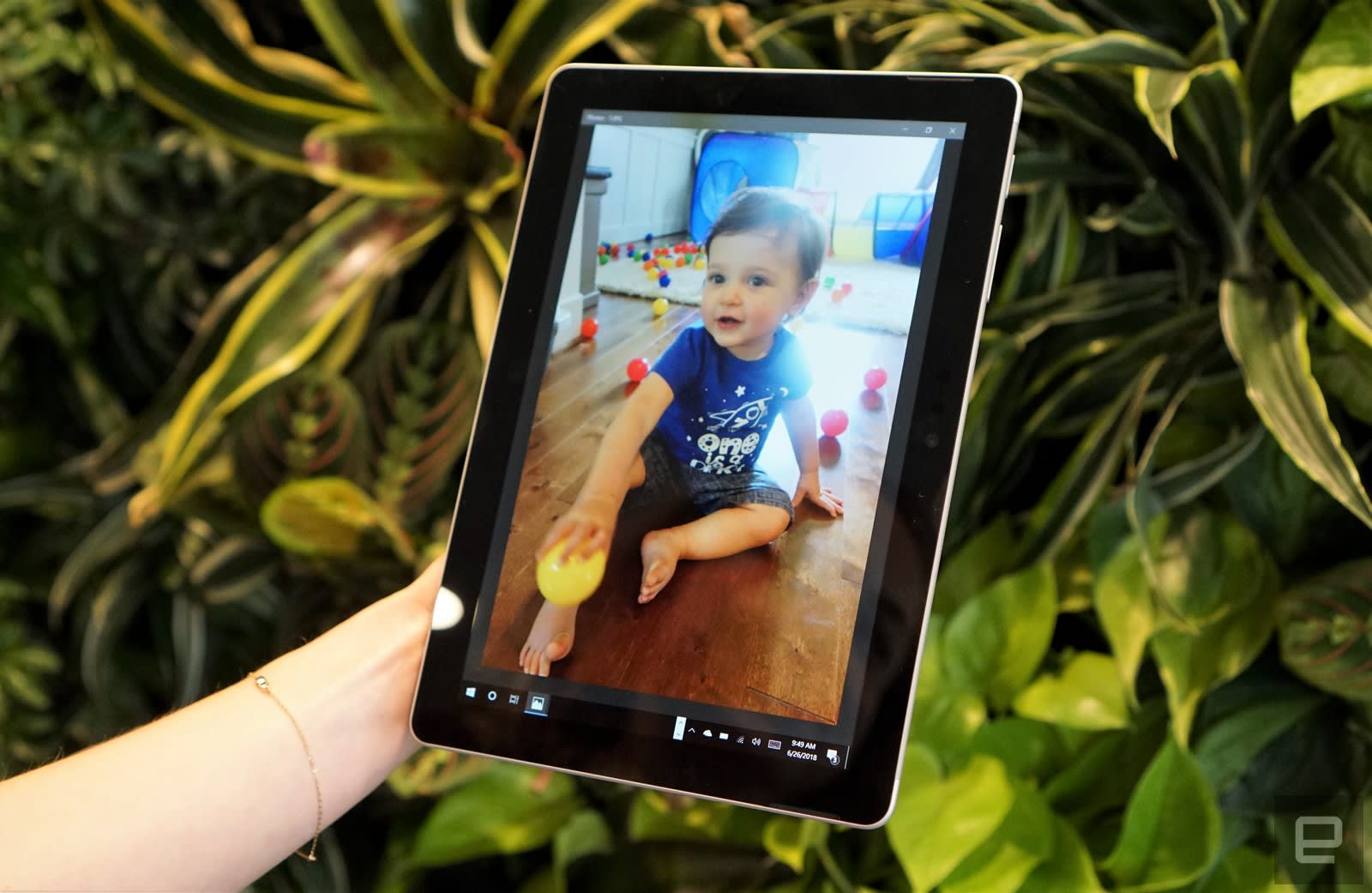 Devindra Hardawar/Engadget Unfortunately, Microsoft didn't slim down the Go's bezels, which are just as chunky as the other Surface slates. They're helpful when holding it as a tablet, something Microsoft reiterated, but it's still a dated look. Just like the last few models, the Surface Go has a Pixelsense screen, meaning it's very thin and closely bonded to the glass, as well as a 3:2 aspect ratio. That makes the tablet taller than standard 16x9 displays, which is more useful for productivity work. The Go features a unique 1,800 by 1,200 pixel resolution (217 pixels per inch), which is just as sharp as the Surface 3's slightly larger 1080p display. Microsoft didn't skimp too much on the Surface Go's screen. It's sharp enough for text and graphically rich images, and it's bright enough to use outdoors in sunlight. While it features an unusual resolution, it's indistinguishable from a standard 1080p screen, which means HD video still looks great. Since the Go has a 3:2 aspect ratio, though, be prepared for black bars when watching widescreen video. 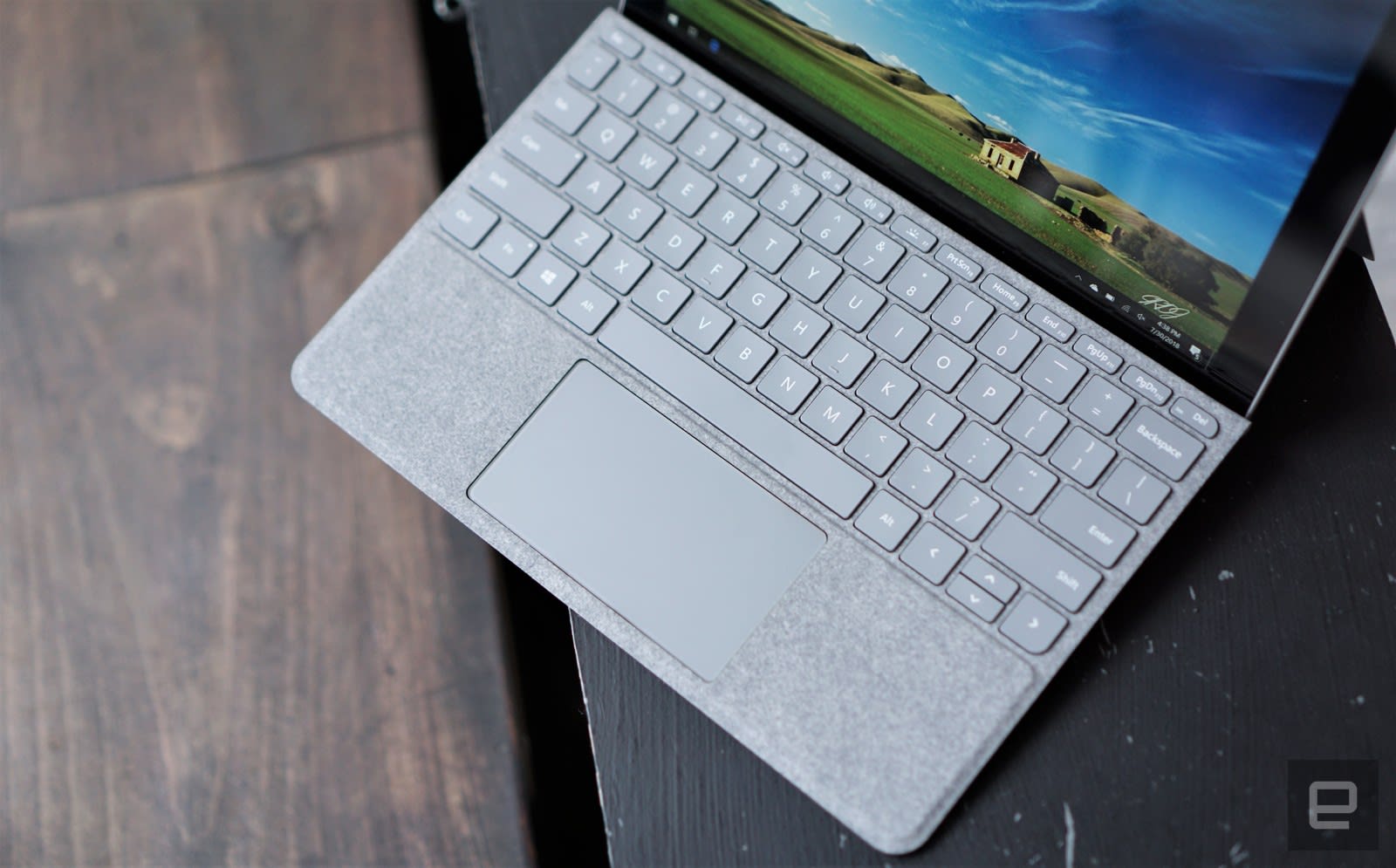
Since Microsoft had to redesign the Surface Go from the Surface 3, it also had to create a new batch of smaller Type Covers. They don't have as much key travel as Microsoft's other tablet keyboards, but there's still a decent amount of feedback. Sadly, they're still sold separately: $99 for the standard models and $129 for the slightly more premium Alcantara-covered version. That's the same cloth-like material Microsoft used on the Surface Laptop and some of its earlier keyboard covers. The Surface Go supports all of the input options you'd expect: 10-point multitouch, as well as the new Surface Pen, which offers 4,096 levels of pressure. There aren't any surprises here. Still, it's interesting to see the Pen working on the Go just as well as it does on all of Microsoft's more expensive computers. As for cameras, there's a 5 megapixel front-facing shooter for video chatting, as well as an 8 megapixel camera in the back. The Surface Go also supports Windows Hello face authentication, which lets you log into your computer easily. Since this is as close to a budget machine we've seen from the Surface lineup, it's surprising to see the Windows Hello camera make the cut. 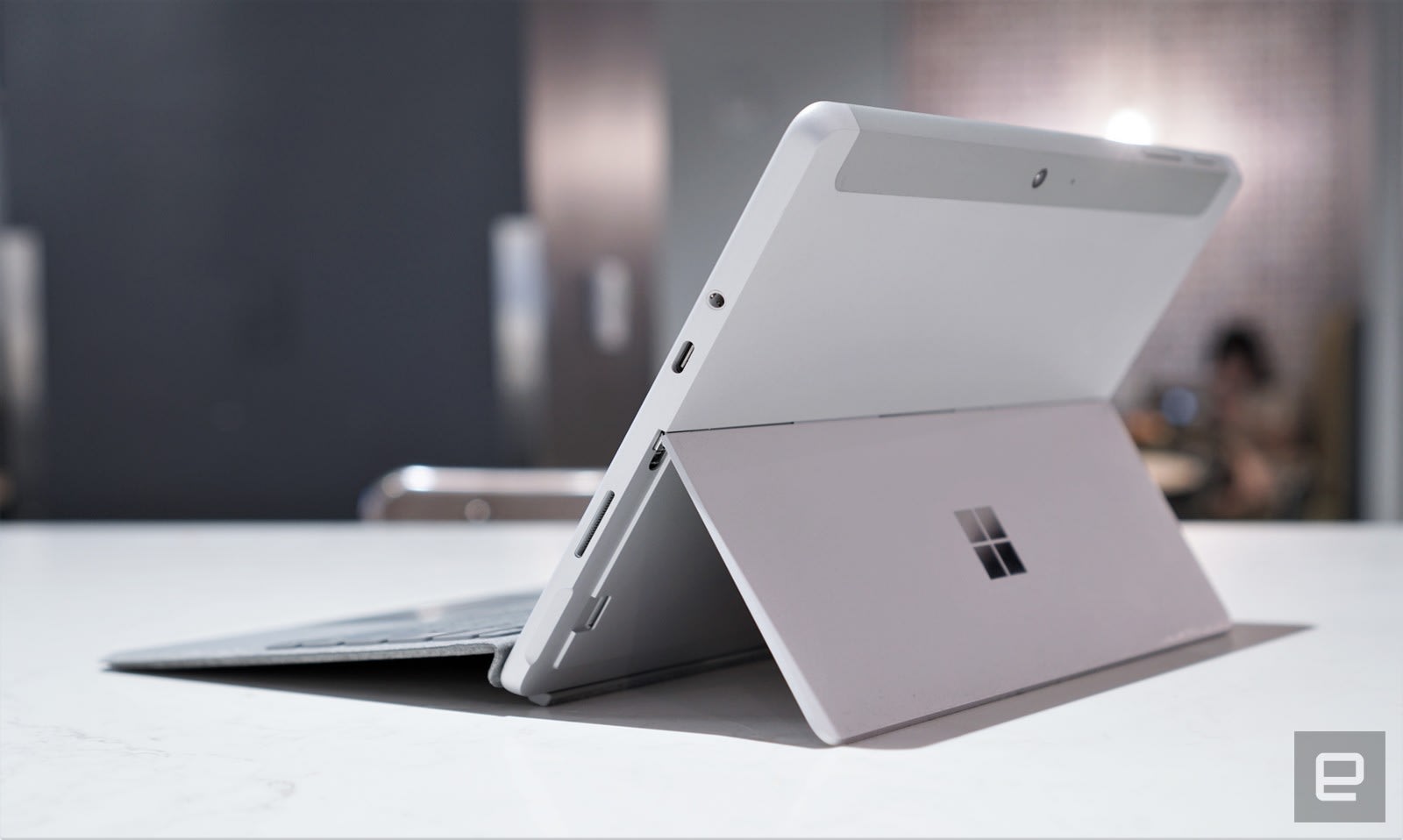 In addition to the standard Surface charging connection (which is now accompanied by a smaller AC adapter), the Go also features a USB-C port, which can also charge the tablet. The Surface Book 2 is the only other device in Microsoft's family that has USB-C. We're finally beginning to see more USB-C devices and accessories on the market, so it's nice to see Microsoft embrace the new port, even though it still insists on including its own charging connection. (It's also strange to think that the Surface 3 actually charged over micro-USB. 2 015 was an odd time.) Microsoft also tucked a microSDXC card reader underneath the Surface Go's kickstand, which lets you quickly add more storage. In addition to the standard Surface charging connection (which is now accompanied by a smaller AC adapter), the Go also features a USB-C port, which can also charge the tablet. The Surface Book 2 is the only other device in Microsoft's family that has USB-C. We're finally beginning to see more USB-C devices and accessories on the market, so it's nice to see Microsoft embrace the new port, even though it still insists on including its own charging connection. (It's also strange to think that the Surface 3 actually charged over micro-USB. 2 015 was an odd time.) Microsoft also tucked a microSDXC card reader underneath the Surface Go's kickstand, which lets you quickly add more storage.
In use 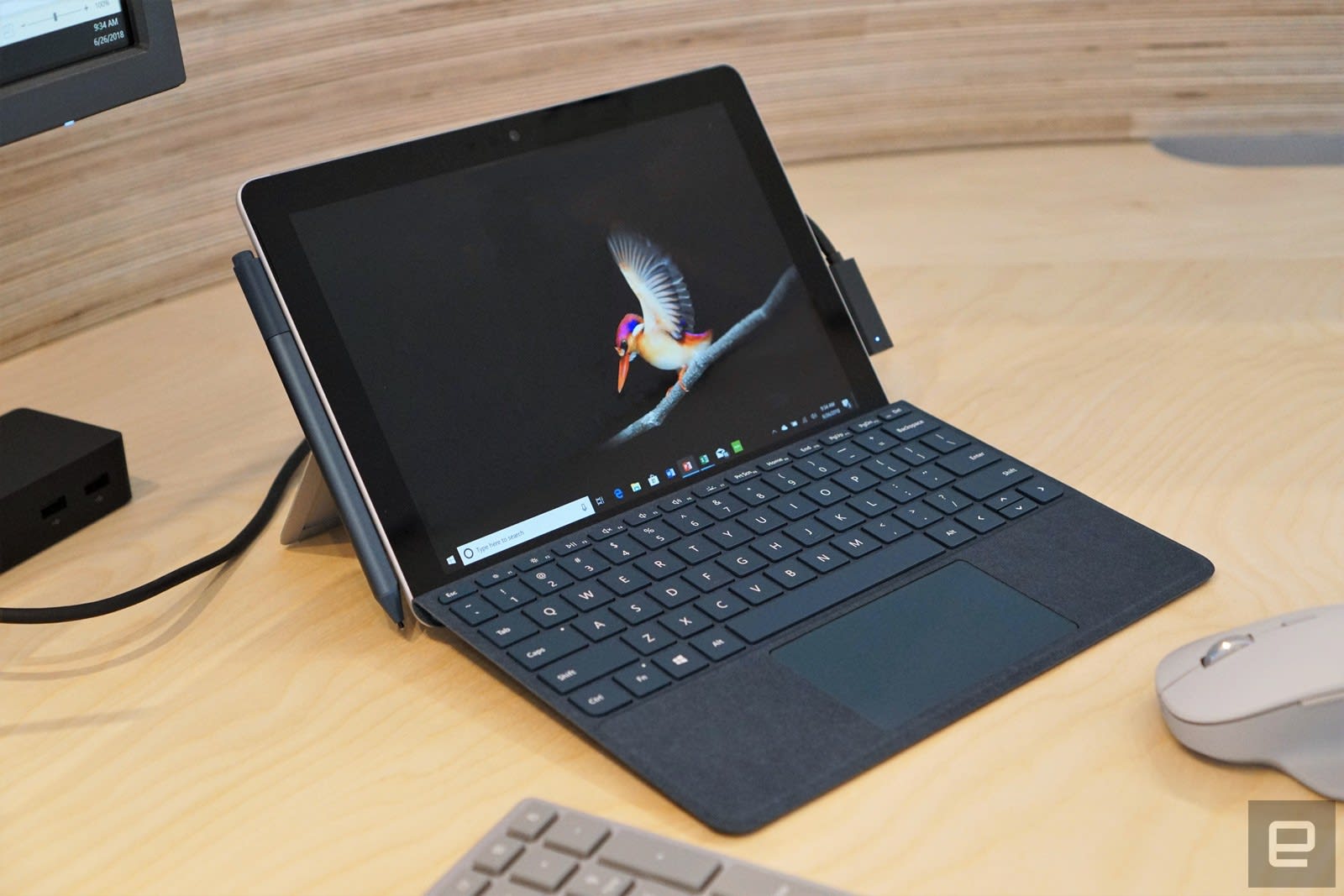 Devindra Hardawar/Engadget More so than any Surface before it, the Go feels like a tablet instead of a PC. Its slightly curved edges make it comfortable in your hands, and it's light enough that I didn't mind holding it for hours as I read comics and caught up on my Pocket queue. It easily fits into slim messenger bags, and doesn't feel as burdensome as a typical ultraportable laptop, or even the Surface Pro (which weighs 2.4 pounds with its Type Cover). Most importantly, it does all of this while still giving me access to everything Windows 10 offers. But like any ultra-slim machine, there are compromises. For one, the Surface Go ships with Windows 10 S, which limits you to apps from the Microsoft Store. You can switch to unfettered Windows 10 Home for free (which I did for this review), but that's still an added layer of confusion. Plenty of people might be scared off by the warnings that appear the first time you try to install a third-party app while in S Mode. It's understandable why Microsoft wants to control the app experience a bit, since rogue software is a major reason why PCs end up feeling sluggish over time, not to mention they can also be a major security risk. But the restrictive approach feels unpalatable when the Microsoft Store is still a barren wasteland. There are a handful of popular apps, like iTunes, Spotify and Netflix, but you won't find any major newspapers like the New York Times, or apps that take advantage of the tablet format. Instead, you'll find yourself spending more time browsing websites in Edge. And while it's nice to have a native web experience in a tablet, I longed for apps actually optimized for slates, like you'd find on iOS and Android. We're used to tablets being consumption devices, and the Surface Go fails a bit in that respect, since Windows 10 isn't specifically geared towards slates. 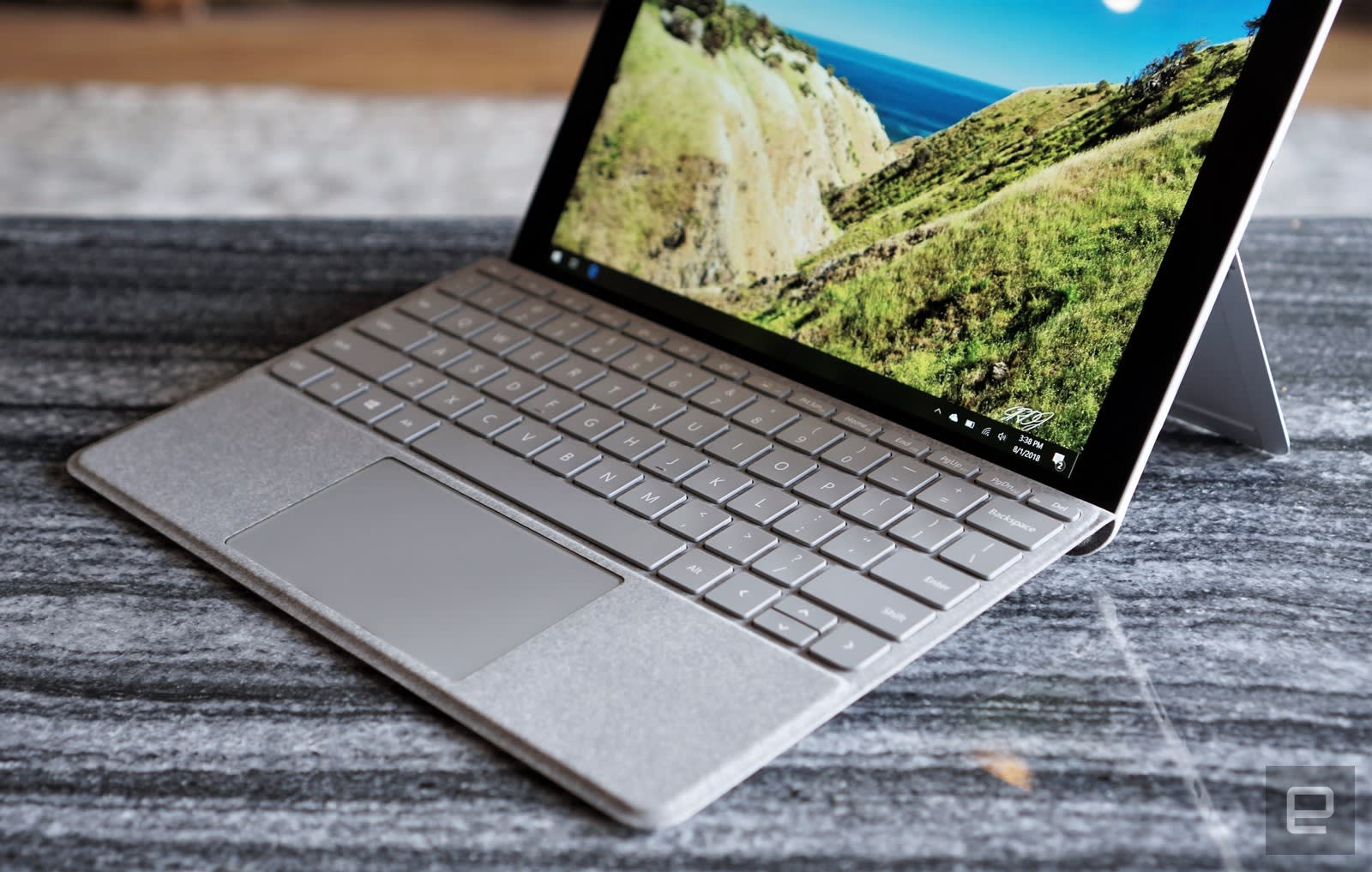
But on a rosier note, the Surface Go shines when it comes to being productive. Mostly, that's because Microsoft delivered another killer Type Cover. The smaller form factor takes a bit of getting used to, but it wasn't long before my fingers were flying across the keys. Touch typists will appreciate how Microsoft shrunk down the standard keyboard layout, and there's a slight curve along the keys to guide your fingers to them. I had no trouble writing most of this review and long articles on the Go's Type Cover. That's more than I can say for Apple's iPad Pro Smart Keyboard, which feels like you're typing on a soiled sponge. I was surprised that Microsoft was also able to fit in a large glass-covered trackpad and that it feels just as good as the Surface Pro's. It's smoother and more responsive than most laptop touchpads I've used. If you haven't used the Surface kickstand before, there's a slight learning curve, especially as you figure out how to balance it on your lap. But while it might take some finagling, I've learned to appreciate the flexibility. It works best on a flat table, but I was also able to use it in a variety of other situations, including: on a cushion while reclining on my couch and on top of my duvet in bed. Sure, it's not as stable as a traditional laptop, but the Go's kickstand is far more functional than something like the iPad Pro's foldable keyboard cover, which only works on perfectly flat surfaces. Performance and battery life | PCMark 7 | PCMark 8 (Creative Accelerated) | 3DMark 11 | 3DMark (Sky Diver) | ATTO (top reads/writes) | | Surface Go (1.6GHz Intel Pentium Gold 4415Y, Intel HD 615) | 3,761 | 2,785 | E2,210 / P1,369 | 3,058 | 1.25 GB/s / 118 MB/s | | Surface 3 (1.6GHz Atom x7-Z8700, Intel HD Graphics) | 2,839 | N/A | E941 / P552 | N/A | 163 MB/s / 39.2 MB/s | | Surface Pro (2017, Core i5, Intel HD 620) | 5,731 | 4,475 | E2,782 / P1,666 / X431 | 4,260 | 1.6 GB/s / 817 MB/s | | Microsoft Surface Laptop (Core i5, Intel HD 620) | 5,075 | 4,279 | E2,974 / P1,702 / X429 | 3,630 | 658 MB/s / 238 MB/s | | Microsoft Surface Pro 4 (2.4GHz Core i5-6300U, Intel HD 520) | 5,403 | 3,602 | E2,697/ P1,556/ X422 | 3,614 | 1.6 GB/s / 529 MB/s | | Dell XPS 13 2-in-1 (1.3GHz Core i7-7Y75, Intel HD 615) | 4,401 | 3,823 | E1,857 / P1,019 / X315 | 2,446 | 1.63 GB/s / 790 MB/s | | Lenovo Yoga 910 (2.7GHz Core i7-7500U, Intel HD 620) | 5,822 | 4,108 | E2,927 / P1,651 / X438 | 3,869 | 1.59 GB/s / 313 MB/s | | HP Spectre x360 (2016, 2.7GHz Core i7-7500U, Intel HD 620) | 5,515 | 4,354 | E2,656 / P1,720 / X444 | 3,743 | 1.76 GB/s / 579 MB/s | While I found myself more productive with the Surface Go than any other tablet, I still had to keep my expectations in check. It's limited by the dual-core Pentium Gold 4415Y CPU, a low-power seventh-generation Intel processor. Microsoft claims its around 30 percent faster than the Atom that was used in the Surface 3, and our benchmarks show it's a noticeable improvement. But it still feels like an odd choice for a machine in 2018. (Or maybe I'm just chafing at saying "Pentium" again.) With our review model -- the slightly souped-up $549 Surface Go with 8GB of RAM -- I was able to juggle between multiple Chrome and Edge tabs, Evernote, Spotify and Slack easily. But the Pentium Gold CPU sometimes had trouble keeping up when I tried to load a complex web page with embedded video, or when Onedrive decided it needed re-synchronize all of my files. Basically, any task that's the least bit demanding would rocket my CPU usage up to 100 percent. 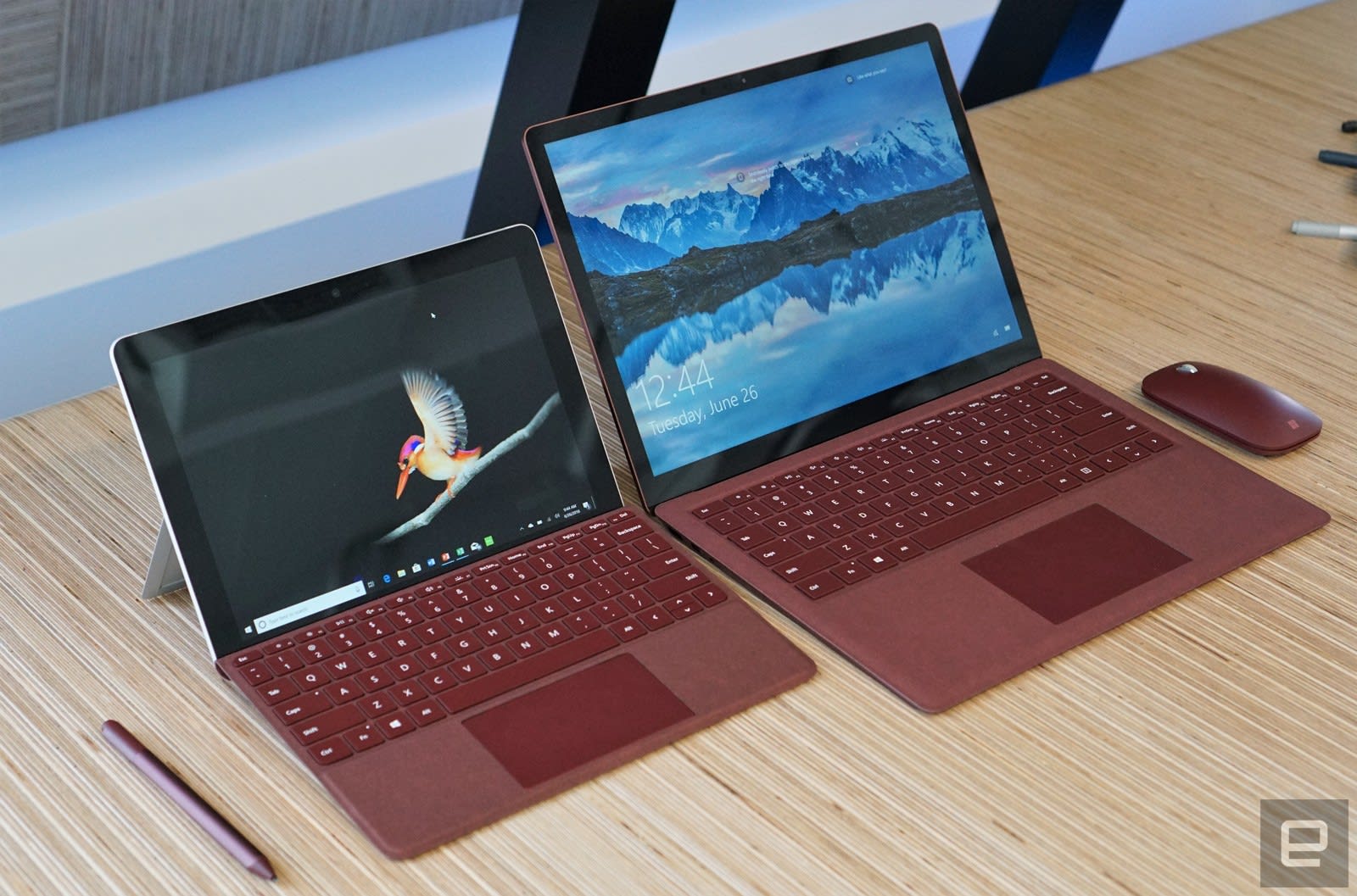 The Surface Go (left) alongside the Surface Laptop (right). Devindra Hardawar/Engadget With all of my usual apps open, I typically used around 70 to 80 percent of the Surface Go's 8GB of RAM. I felt flashbacks to a decade ago, when I had to keep a close eye on memory usage on all my PCs. Though, the situation would certainly be worse on the entry-level Surface with 4GB of RAM. The thought of using a Windows 10 PC with so little memory makes me anxious. Eventually, I had to train myself not to think of the Surface Go as a full-fledged PC, but a tablet that could occasionally open up Windows 10 applications when I needed them. You'll have no trouble if you're using it to browse a few web pages, or watching Netflix. It can even handle several Office documents simultaneously. Just don't go overboard and launch dozens of browser tabs, multiple YouTube videos, and Photoshop at the same time. In our battery test, which involves looping an HD video until the computer dies, we the Surface Go clocked in at 9 hours and 50 minutes, well above Microsoft's 9 hour estimate. Of course, that figure will drop precipitously depending on what you're doing. With my usual workflow, it typically lasted around six hours before the battery completely drained. | Battery life | | Surface Go | 9:50 | | Surface 3 | 9:11 | | Surface Pro (2017) | 13:40 | | Surface Laptop | 14:49 | | Lenovo Yoga 910 | 16:13 | | HP Spectre x360 (13-inch, 2015) | 11:34 | | HP Spectre x360 15t | 10:17 | | Apple MacBook (2016) | 8:45 | | Dell XPS 2-in-1 | 8:34 | | Microsoft Surface Pro 4 | 7:15 | Pricing and the competition 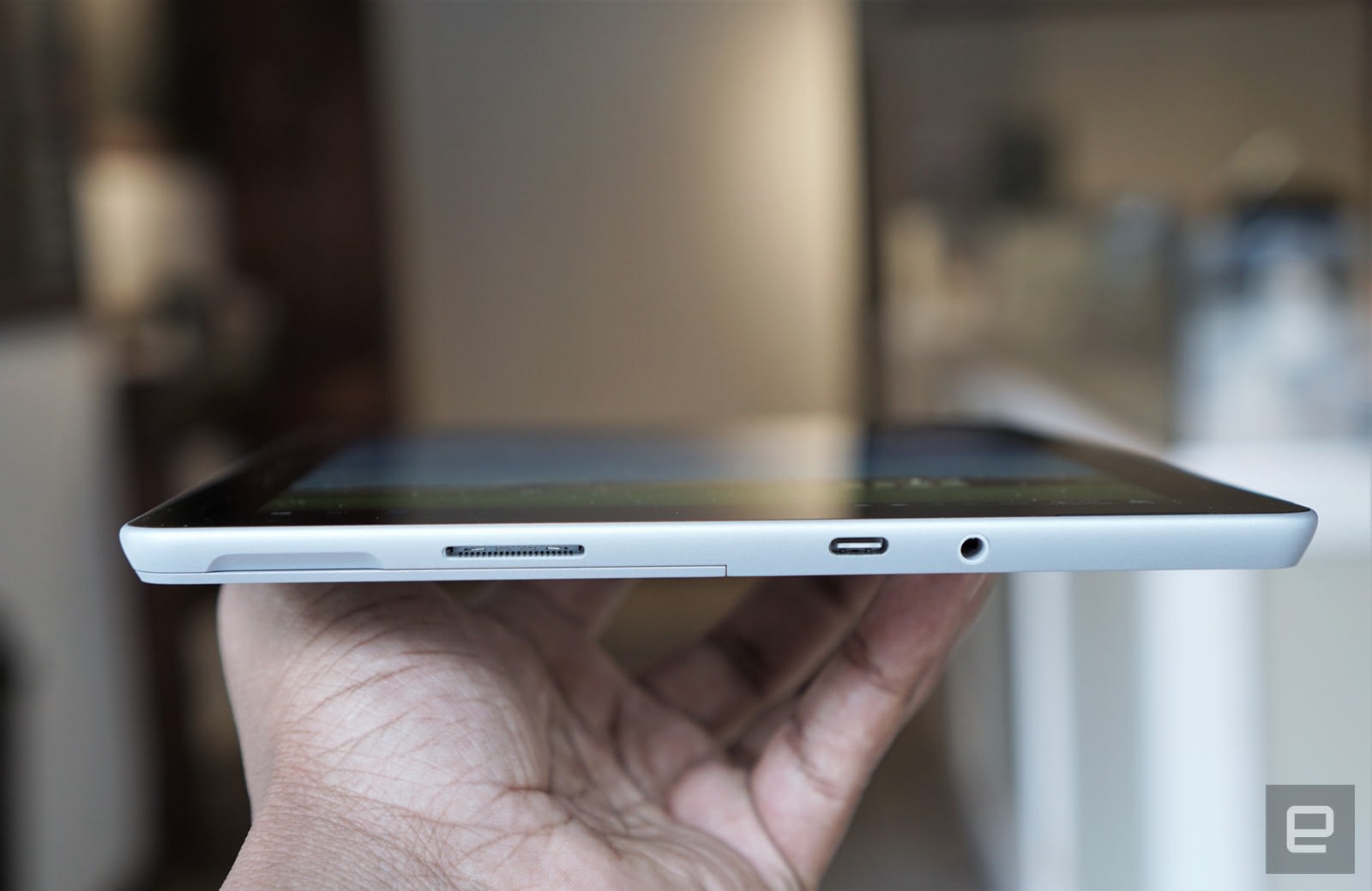
The Surface Go starts at $399 with the Pentium Gold CPU, 4GB of RAM, and 64GB of eMMC storage. The step-up option, which we reviewed, goes for $549 with the same CPU, 8GB of RAM and a 128GB SSD. Given that eMMC storage is notoriously slow, and 4GB is practically useless, I'd recommend considering the more powerful model if you plan to move lots of data. And don't forget, you'll have to pay another $99 for the Type Cover (or $129 for the Alcantara version), and another $100 for the Surface Pen. ASUS's Transformer Mini is similar to the Surface Go, with an integrated kickstand and 10-inch screen. It's a better deal, starting at around $379 with a bundled keyboard and stylus. But it's just as underpowered as the Go, with an Atom X5 processor and 4GB of RAM. You can also nab Apple's latest iPad for $329 with 32GB of storage, or $429 with 128GB. You'll have to add a third-party keyboard if you plan to type a lot though, which will typically run you around $100. Apple's keyboards only work with the more expensive iPad Pro (and personally, I'd recommend a Logitech model over those). On the Android front, there's Samsung's upcoming Galaxy Tab S4, a pricey $650 option, but one that also has a gorgeous AMOLED screen and a bundled stylus. Wrap-up 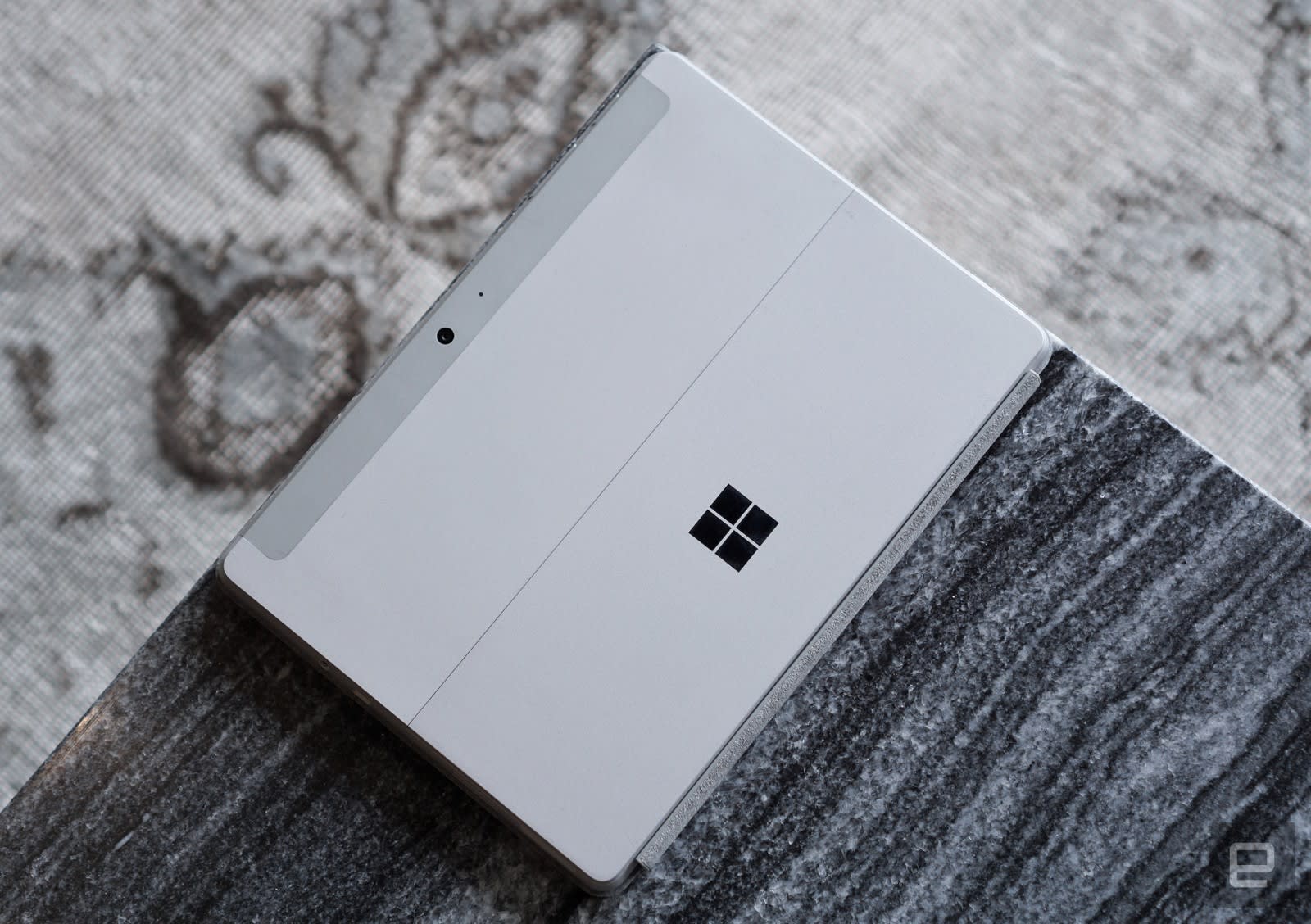
Even though the Surface Go is technically a PC, it's mainly competing with tablets. And just as you wouldn't want to replace your computer entirely with an iPad, you shouldn't think of the Go as your primary machine. Instead, it's more of a secondary device, one that you can carry around all day when you don't feel like lugging a larger laptop. I'll admit, the Surface Go is full of compromises. It's slow, and it's limited by Windows 10's slim tablet app selection. But it also has a keyboard that blows away any other tablet, and it can run normal Windows software if necessary. It's not meant for everyone, but if you're in the niche it's targeted at, it could the Windows tablet you've been waiting for.
via Engadget RSS Feed https://ift.tt/2AzsSdT |
Comments
Post a Comment